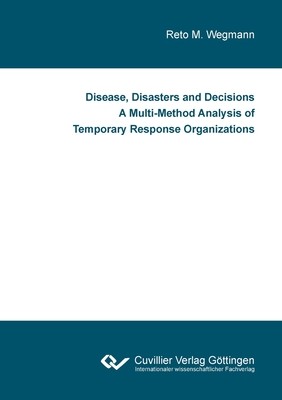
- We will send in 10–14 business days.
- Author: Reto M Wegmann
- Publisher: Cuvillier
- ISBN-10: 3736974701
- ISBN-13: 9783736974708
- Format: 14.8 x 21 x 0.8 cm, softcover
- Language: English
- SAVE -10% with code: EXTRA
Disease, Disasters and Decisions A Multi-Method Analysis of Temporary Response Organizations (e-book) (used book) | bookbook.eu
Reviews
Description
Disasters and diseases have shaped history from Mount Vesuvius burying Pompeii until today's societies struggling through the Covid-19 pandemic. They result in critical economic and human losses, and sometimes in changed political power balances. Diseases and disasters are so important for the world and its global population, that they are researched by various academic disciplines, and they appear in all great holy scriptures. This dissertation aims to contribute to our understanding of performance of temporary response organizations by determining respective performance predictors. Contributing to handling two of the world's greatest scourges may result in massively reducing the occurring economic costs - and even in human lives saved. The overall research question is: How can the performance of temporary organizations responding to disasters and disease outbreaks be predicted? Reto Wegmann's dissertation is structured in six chapters. It starts with introductory remarks in Chapter 1, and explains theoretical backgrounds as well as terms and definitions in Chapter 2. Chapter 3 inducts organizational performance predictors, which are then used to generate hypotheses, which are empirically tested against different data sets, in Chapter 4 and Chapter 5. Chapter 6 concludes the dissertation by summarizing the insights gained, proposing theoretical and practical conclusions, pointing out the limitations and strengths and weaknesses, and by outlining multiple paths for future research.
EXTRA 10 % discount with code: EXTRA
The promotion ends in 19d.22:18:13
The discount code is valid when purchasing from 10 €. Discounts do not stack.
- Author: Reto M Wegmann
- Publisher: Cuvillier
- ISBN-10: 3736974701
- ISBN-13: 9783736974708
- Format: 14.8 x 21 x 0.8 cm, softcover
- Language: English English
Disasters and diseases have shaped history from Mount Vesuvius burying Pompeii until today's societies struggling through the Covid-19 pandemic. They result in critical economic and human losses, and sometimes in changed political power balances. Diseases and disasters are so important for the world and its global population, that they are researched by various academic disciplines, and they appear in all great holy scriptures. This dissertation aims to contribute to our understanding of performance of temporary response organizations by determining respective performance predictors. Contributing to handling two of the world's greatest scourges may result in massively reducing the occurring economic costs - and even in human lives saved. The overall research question is: How can the performance of temporary organizations responding to disasters and disease outbreaks be predicted? Reto Wegmann's dissertation is structured in six chapters. It starts with introductory remarks in Chapter 1, and explains theoretical backgrounds as well as terms and definitions in Chapter 2. Chapter 3 inducts organizational performance predictors, which are then used to generate hypotheses, which are empirically tested against different data sets, in Chapter 4 and Chapter 5. Chapter 6 concludes the dissertation by summarizing the insights gained, proposing theoretical and practical conclusions, pointing out the limitations and strengths and weaknesses, and by outlining multiple paths for future research.


Reviews